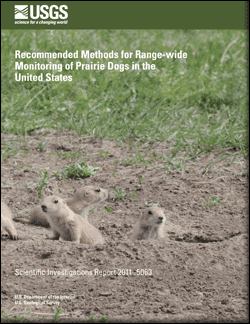Scientific Investigations Report 2011–5063
1WEST, Inc., 200 South Second Street, Laramie, WY 82070
2U.S. Geological Survey, Fort Collins Science Center, 2150 Centre Avenue,
Building C, Fort Collins, CO 80526
3U.S. Geological Survey, Iowa Cooperative Fish and Wildlife Research
Unit, Iowa State University, Ames, IA 50010
4Wildlife Conservation and Management, School of Natural Resources
and the Environment, 306 Biological Sciences East, University of Arizona,
Tucson, AZ 85721.
5Department of Natural Resources Management, Texas Tech University,
Box 42215, Lubbock, TX 79409.

One of the greatest challenges for conserving grassland, prairie scrub, and shrub-steppe ecosystems is maintaining prairie dog populations across the landscape. Of the four species of prairie dogs found in the United States, the Utah prairie dog (Cynomys parvidens) is listed under the Endangered Species Act (ESA) as threatened, the Gunnison's prairie dog (C. gunnisoni) is a candidate for listing in a portion of its range, and the black-tailed prairie dog (C. ludovicianus) and white-tailed prairie dog (C. leucurus) have each been petitioned for listing at least once in recent history. Although the U.S. Fish and Wildlife Service (USFWS) determined listing is not warranted for either the black-tailed prairie dog or white-tailed prairie dog, the petitions and associated reviews demonstrated the need for the States to monitor and manage for self-sustaining populations. In response to these findings, a multi-State conservation effort was initiated for the nonlisted species which included the following proposed actions: (1) completing an assessment of each prairie dog species in each State, (2) developing a range-wide monitoring protocol for each species using a statistically valid sampling procedure that would allow comparable analyses across States, and (3) monitoring prairie dog status every 3–5 years depending upon the species. To date, each State has completed an assessment and currently is monitoring prairie dog status; however, for some species, the inconsistency in survey methodology has made it difficult to compare data year-to-year or State-to- State. At the Prairie Dog Conservation Team meeting held in November 2008, there was discussion regarding the use of different methods to survey prairie dogs. A recommendation from this meeting was to convene a panel in a workshop-type forum and have the panel review the different methods being used and provide recommendations for range-wide monitoring protocols for each species of prairie dog. Consequently, the Western Association of Fish and Wildlife Agencies (WAFWA), in coordination with USFWS and U.S. Geological Survey (USGS), hosted a prairie dog species survey methodology workshop January 25–28, 2010 in Fort Collins, Colorado. The workshop provided all WAFWA partners and interested parties the opportunity to present their survey methodology to a review panel made up of experts in the fields of quantitative biology, population biology, species biology, and biostatistics. This report presents the panel's survey methodology recommendations for each of the four species of prairie dogs found in the United States and, for the black-tailed prairie dog, a list of action items to facilitate implementation of the recommended methodology. |
First posted May 11, 2011 For additional information contact: This report is presented in Portable Document Format (PDF); the latest version of Adobe Reader or similar software is required to view it. Download the latest version of Adobe Reader, free of charge. |
McDonald, L.L., Stanley, T.R., Otis, D.L., Biggins, D.E., Stevens, P.D., Koprowski, J.L., and Ballard, Warren, 2011, Recommended methods for range-wide monitoring of prairie dogs in the United States: U.S. Geological Survey Scientific Investigations Report 2011–5063, 36 p.
Overview
Introduction
Recommendations
Concluding Remarks
Acknowledgments
References Cited
Appendix 1. Workshop Attendee List
Appendix 2. Homework Questions
Appendix 3. The Need for Prairie Dog Conservation Activities on Focal Areas
Appendix 4. National Agriculture Imagery Program Overview
Appendix 5. Use of Aerial Imagery to Map Features (Potential Prairie Dog Colonies)
Appendix 6. Ground Survey Procedure for Identifying Activity of Colonies